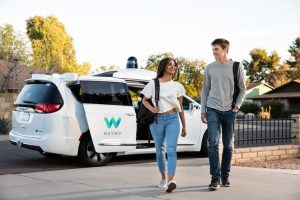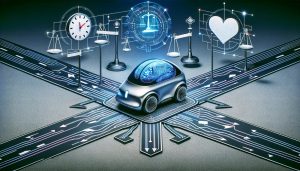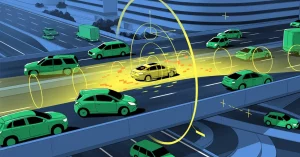The rapid advancement of technology has transformed industries, with Autonomous Vehicles (AVs) and the Internet of Things (IoT) emerging as two of the most revolutionary innovations. Both have wide-ranging impacts on transportation, logistics, safety, and efficiency. This article delves into the development of AVs and IoT, their benefits, examples, challenges, and the potential future they
The rapid advancement of technology has transformed industries, with Autonomous Vehicles (AVs) and the Internet of Things (IoT) emerging as two of the most revolutionary innovations. Both have wide-ranging impacts on transportation, logistics, safety, and efficiency. This article delves into the development of AVs and IoT, their benefits, examples, challenges, and the potential future they hold together.
Development of Autonomous Vehicles

Image by Yandex.com
The history of Autonomous Vehicles (AVs) dates back to the 1980s, when universities started researching two types of AVs: one that required roadway infrastructure and one that didn’t. The U.S. Defense Advanced Research Projects Agency (DARPA) played a crucial role in advancing AV technology through a series of “grand challenges.” These challenges tested AVs on off-road courses, with initial attempts in 2004 being unsuccessful. However, by 2007, several teams were able to navigate a 60-mile urban course, following regular traffic laws.
In 2015, the University of Michigan established Mcity, the first-ever facility dedicated to testing AVs. This center conducts research on the safety, efficiency, accessibility, and commercial viability of AVs, helping pave the way for mainstream adoption.
IoT’s journey is similarly impressive. Emerging from technological roots in the 1970s, the concept of connected devices gained significant momentum in the late 1990s when Kevin Ashton coined the term. By 2020, IoT had matured to connect millions of devices across homes, industries, and cities, creating vast networks of smart devices and sensors.
Autonomous Vehicle Technologies and IoT
AVs rely on a variety of sensors and technologies, including:
- LIDAR (Light Detection and Ranging): Used for detecting objects around the vehicle.
- RADAR: Measures the distance and speed of surrounding objects.
- Cameras: Capture real-time images to identify traffic signs, lanes, and pedestrians.
- GPS and Advanced Mapping Systems: Guide AVs along optimal routes.
Similarly, IoT devices rely on connectivity protocols (e.g., Zigbee, 6LoWPAN), sensors, and actuators to monitor, analyze, and act on data in real time. These technologies allow devices to communicate autonomously, much like AVs.
Benefits of Autonomous Vehicles and IoT

Image by Yandex.com
Both AVs and IoT hold immense potential across various sectors. Below are key benefits of each:
Benefits of Autonomous Vehicles:
- Enhanced Safety: AVs reduce human errors, which account for 94% of all road accidents. By employing advanced sensors and algorithms, AVs can make split-second decisions to avoid collisions.
- Increased Efficiency: Eco-driving techniques can reduce fuel consumption by up to 20%, leading to cost savings and a smaller carbon footprint.
- Reduced Traffic Congestion: Improved traffic flow management could lower fuel consumption by 0-4% and shorten commute times, providing a smoother driving experience for all road users.
- Accessibility: AVs could offer mobility to the elderly and disabled, creating new user groups and fostering independence.
- Energy Savings: Right-sizing vehicles and optimized driving can lower fuel consumption by up to 45%, contributing to a greener environment.
- Economic Growth: The widespread adoption of AVs could create new jobs in tech, maintenance, and regulation while reshaping transportation-related industries.
- Reduced Insurance Costs: As AV technology matures and demonstrates safety improvements, insurance premiums may decrease, making transportation more affordable.
Benefits of IoT:
- Automation: IoT enables devices to perform tasks automatically, reducing human intervention and errors, leading to increased productivity.
- Data-Driven Decisions: Real-time data collection helps businesses and individuals make informed decisions, enhancing operational efficiency and customer satisfaction.
- Cost Efficiency: Smart devices reduce energy consumption and operational costs in homes and industries, with potential savings of up to 30%.
- Enhanced Security: IoT enables advanced monitoring and security solutions, particularly in smart homes and cities, providing peace of mind to users.
- Personalization: IoT can customize user experiences, such as in smart homes where devices adapt to individual preferences for lighting, temperature, and security.
- Improved Health Monitoring: In healthcare, IoT devices enable remote monitoring of patients, enhancing preventive care and reducing hospital visits.
- Sustainable Practices: IoT can optimize resource use in industries, reducing waste and environmental impact through smarter management of energy and materials.
Analysis Table: Autonomous Vehicles vs. IoT Benefits
| Category | Autonomous Vehicles (AVs) | Internet of Things (IoT) |
|---|---|---|
| Safety | Reduces human error in driving, leading to fewer accidents | Provides real-time monitoring for better security |
| Efficiency | Eco-driving can cut fuel consumption by 20% | Streamlines processes through automation |
| Energy Savings | Right-sizing vehicles saves up to 45% of energy | Reduces waste through intelligent energy management |
| Accessibility | Improves mobility for disabled and elderly populations | Offers smart solutions for easier living |
| Cost Reduction | Lowers insurance costs and increases fuel efficiency | Decreases energy and operational costs |
| Data Collection | Enables real-time data for improved traffic and driving behavior | Enables data-driven decisions for industries and consumers |
Challenges and Limitations
Both AVs and IoT face significant barriers to widespread adoption:
Challenges of Autonomous Vehicles:

Image by Yandex.com
- Regulation: The U.S. currently has no national framework for AVs. While some states have enacted legislation, a standardized approach is needed.
- Liability: Determining fault in the event of an AV crash is a legal challenge that has yet to be fully addressed.
- Cybersecurity: AVs are vulnerable to hacking, posing risks to data privacy and safety.
- Weather Dependency: Poor weather conditions, such as snow or heavy rain, can impair the performance of AV sensors.
Challenges of IoT:
- Security Concerns: As more devices become interconnected, the potential for cyberattacks increases, creating privacy risks.
- Complexity in Device Management: Managing and integrating a growing number of IoT devices can be challenging.
- Compatibility Issues: The lack of standardization leads to difficulties in ensuring devices from different manufacturers work together.
Case Study: Waymo and Tesla in Autonomous Vehicle Development
Waymo, a pioneer in AV technology, has tested its vehicles over 20 million miles on public roads and billions of miles in simulations. Its success highlights the potential of AVs to revolutionize transportation.
Tesla, on the other hand, has deployed Autopilot mode across its fleet, with Teslas driving over 3 billion miles in this semi-autonomous mode since 2014. However, Tesla’s journey has not been without challenges, such as the 2016 fatal crash involving a Model S in Autopilot mode. This incident highlighted the complexities of liability and regulation surrounding AV technology.
Future Outlook
The future of Autonomous Vehicles and IoT appears intertwined. AVs could leverage IoT networks for real-time data sharing between vehicles and infrastructure, improving navigation and safety. IoT-based smart cities could seamlessly integrate AVs into traffic systems, optimizing routes and reducing congestion.
Projections suggest that Level 5 autonomous vehicles (full autonomy) may be commercially available by 2030. In parallel, IoT adoption is expected to surge, with the number of connected devices projected to exceed 50 billion by 2030.
Conclusion
Autonomous vehicles and IoT are reshaping the technological landscape. While both offer immense benefits, they also face challenges that must be addressed through innovation, regulation, and societal adaptation. Together, these technologies have the potential to create a future of safer, more efficient, and interconnected transportation systems while also transforming industries, homes, and cities.
















